Authored by Tahani Al-Ghareeb*,
Abstract
Chloride-induced corrosion of steel reinforcement and the reaction of atmospheric carbon dioxide with cement paste are the most important causes of premature failure in marine-reinforced concrete structures. Among the available methods, corrosion inhibitors offer a simple and costeffective technique in reducing the chloride-induced corrosion on the steel reinforced concrete.
This study was conducted to evaluate the efficacy of adding two commercial concrete admixtures named Migrating Corrosion Inhibitor (MCI) and Waterproofing Concrete Admixture (HCA) to Ordinary Portland Cement (OPC) in order to protect steel reinforcement from corrosion in seawater environment and was aimed at studying the effect of using sulphate resistant cement (SRC) in concrete mix for marine structures. The effectiveness of the inhibitors was evaluated both in the field and in the laboratory using long-term rebar corrosion monitoring in reinforced concrete, electrochemical corrosion testing techniques, corrosion potential and also through rebar visual inspection. The evaluation was performed on eight different types of concrete mixes and two different water cement (w/c) ratios of 0.4 and 0.6 with regular steel rebar.
From the tests and study, the compressive strength and water absorption of the concretes cured with fresh water is better performance than those cured with seawater. The concretes mixed with admixtures (MCI and HCA) have lower water absorption than the control mix, which have an OPC and no inhibitors. The HCA mixed concrete samples showed the better compressive strength and water resistance than the MCI mixed concrete samples at same w/c ratios.
The concrete samples injected with MCI and HCA have higher corrosion resistivity compared to the concrete samples without admixture chemicals. Whilst injection of HCA in OPC Concretes improved the corrosion resistivity than injection of MCI.
Keywords: Seawater environment; Steel reinforced concrete; Corrosion; Migrating corrosion inhibitor (MCI); Waterproofing concrete admixture (HCA)
Introduction
Concrete is a particulate composite in which an aggregate, usually gravel and sand, is bonded in a matrix of Portland cement and water. A cementation reaction between water and minerals in the cement provides the required strength of the concrete. This cement binder provides physical protection to the embedded steel in it by means of the cover and impedes the access of aggressive species to the steel reinforcement. Good quality concrete also provides chemical protection to the steel with the formation of highly alkaline pore solution. The highly alkaline environment in the concrete promotes the formation of an adhering passive film in the surface of the steel, which protects it from corrosion.
Although corrosion of steel does not commonly occur in concrete, penetration of unfavorable chemical species can destroy the protective environment and eventually cause corrosion of the steel. Significant chemical species that can breakdown the passive film on the steel reinforced concrete are carbon dioxide and chlorides [1]. Carbon dioxide has a slow ingress to the concrete paste and reacts with the alkaline components in the concrete, neutralizing the alkalinity. While the chloride ion attacks the passive layer but, unlike carbonation, chlorides are not consumed in the process but help to break down the passive layer of oxide on the steel and allow the corrosion process to proceed quickly. The conceptually derived Evans diagram at Figure 1 represents the effect of increasing chloride concentration on the reinforcement corrosion rate.

Limiting salts in concrete ingredients, lowering the water-tocement (w/c) ratio mixes, having adequate concrete cover, and using corrosion protection systems, could efficiently reduce the corrosion process. The use of corrosion protection systems, such as corrosion-inhibiting chemical admixtures and supplementary cementing materials, increases the construction cost, but the cost is marginal compared with the cost of repair of the structure, because of premature deterioration [3]. Among the available methods, corrosion inhibitors offer a practical and cost-effective protection method, primarily with the aim of effectively reducing the chlorideinduced corrosion in reinforced concrete.
Chloride-induced corrosion of carbon steel reinforcement and the reaction of atmospheric CO2 with cement paste are the most important cause of premature failure of reinforced concrete structures [4]. Among available methods, corrosion inhibitors offer a simple and cost effective prevention technique, primarily to prevent and stop chloride-induced corrosion. Nevertheless, performance of commercial inhibitors is only partially satisfactory, since there is not yet a clear knowledge on the real effectiveness of these products in the field under Kuwaiti environment.
The objective of this study is to evaluate the effectiveness of adding two commercial chemical agents entitled Migrating Corrosion Inhibitor (MCI) and Waterproofing Concrete Admixture (HCA) to Ordinary Portland Cement (OPC) and Sulfate Resistant Cement (SRC) concrete mix in order to protect steel reinforcement from marine corrosion. This evaluation was performed on two different water cement (0.4 and 0.6 w/c) ratios with regular steel rebar’s serving tests in the lab and marine field premises.
Migrating corrosion inhibitor (MCI)
The MCI can be applied either directly on the concrete surface or as an admixture while mixing concrete. [5]. It diffuses through concrete to form a monolayer film at the interface between concrete and steel reinforcement, which supports both anodic and cathodic corrosion reaction by preventing the passage of aggressive chloride ions (Cl-) and other corrosion-induced species through this film.
The specifications mention that MCI is a water-based organic corrosion-inhibiting admixture for the protection of reinforcement in concrete. In addition, when incorporated into concrete, the MCI migrates toward the reinforcement and forms a monomolecular layer that inhibits the corrosion reaction on both anodic and cathodic components of the corrosion cell. This chemical is compatible with all types of Portland cements, mineral admixtures, super plasticizers, accelerators and air entraining admixtures. The manufacturer recommended dosage of 0.6 l/m3 that was used in the preliminary tests for casting concrete.
The physical characteristics of the material are given in Table 1.
Waterproofing concrete admixture (HCA)
When the Waterproofing admixture is added to concrete, it reacts with metal ions to form an insoluble organic metallic salt. This would reduce the porosity of concrete and increase its resistance to the penetration of water and chlorides [6]. Molecules of this salt have a long chain of hydrocarbon on one end that resists water and a polar end that is also attached to reinforcing steel and chained together, creating a protective layer against chlorides, oxygen, and moisture. At the surface of the reinforcing steel, the admixture chemical reacts with ferrous ions and forms a stable layer.
The manufacturer recommended dosage of 10 l/m3 was used in the preliminary concrete test specimens. General properties and characteristics of the waterproofing admixture are given in Table 2.
Table 1: Physical characteristics of MCI.

Table 2: Physical characteristics of HCA.

Testing Program
Eight different concrete mixes two cement types, namely, the OPC and SRC (sulfate-resistant cement) at two levels of w/c ratios (0.4 and 0.6) to resemble normal to stringent concrete quality.
Two corrosion-inhibiting admixtures, HCA and MCI were used with each set of concrete mixed with OPC. The design strength of four of the concrete mixes was 25 MPa, while the remaining concrete mixes were designed to have a compressive strength of 40 MPa. Mixes 1 and 2 were the control mixes, which have an OPC and no inhibitors. In Mixes 3 and 4, the OPC was replaced with the SRC. Mixes 5 and 6 were similar to Mixes 1 and 2, respectively with the addition of MCI; while to Mixes 7 and 8, HCA was added. The details of mix design for eight different mixes are given in Table 3. Concrete mixes were prepared for a preliminary study based on this mix design.
Table 3: Concrete Mix Design per Meter cube for Eight Different Mixes.
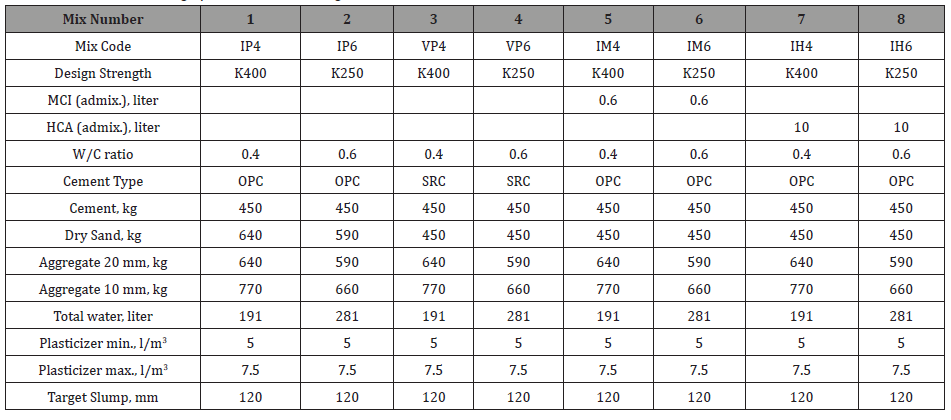
The concentrations of the admixtures were based on the supplier’s recommendations that are 10 l/m3 and 0.6 l/m3 for the HCA and MCI, respectively. Mixtures with 0.4 w/c ratio were designed for K400 and 0.6 w/c ratio for K250.
In the preliminary casting, concrete specimens were casted in 100 mm x 100 mm x100 mm cubes, as well as a 100 mm x 200 mm cylinder. Three specimens were tested at the age of 3, 7 and 28,365 days for their compressive strength according to the ASTM standard C39M-10 [10].
Methodology of Concrete Testing
Compressive strength
Concrete cubes of sizes 100X100X100 mm3 were prepared from all the mixes. Compressive Strength Test was conducted during the process of curing concrete samples. As the hydration takes place and the curing process progresses, capillary pores are filed with hydration products. The capillary porosity of the paste depends on both w/c ratio of the mix and degree of hydration. In this study, concrete cubes of each mix were cured in normal and seawater curing and tested for compressive strength at 1 day, 3 days, 7 days, 28 days, 6 months, 1 year, and 2 years. Three concrete cubes were tested from each mix after each curing period. Strength gain development at certain curing intervals was monitored and recorded.
Water absorption test (British Standard 1881-122:2011)
This test was aimed at determining the amount of water absorbed by the concrete specimens. Concrete cubes of size 100 mm X 100 mm X 100 mm were used, as the preliminary specimens, to be tested for water absorption, and the results were corrected to that equivalent to a surface to volume ratio of a core of 75 mm long with diameter of 75 mm according to BS 1881-122:2011 [9]. The test was conducted on concrete at an age of 28 to 32 days. Three concrete specimens from each mix were dried in an oven at the age of 24 to 28 d for 72±2 hours. They were then removed from the oven and cooled in dry airtight vessel for 24±0.5 hours. The weights of the concrete specimens were measured immediately after cooling. After that, the concrete cubes were immersed in water for 30±0.5 minutes, assuring that there was 25±5 mm of water above the top of specimens. After removing the bulk of surface water, the concrete specimens were weighed. According to BS 1881-122: 2011 [9], the water absorption rate of the concrete mixed with water, resisting admixtures, and pore blockers should be measured at the immersing periods of 10, 30, 60, and 120 min. The absorption of each specimen was calculated as the increase in mass resulting from immersion expressed as a percentage of the mass of the dry specimen. Then, the corrected absorption was calculated according to the correction factor explained in BS 1881-122:2011.
Electrical indication test for resistance chloride ion penetration (ASTM C1202, 2010)
(ASTM C1202, 2010) [11]. In this test, a concrete cylinder of 100 mm in diameter and 200 mm in height was prepared and cured for 28 d. A concrete disc of 50 mm height was cut from the middle of the cylinder and was epoxy coated on the side. This disc was specially prepared to ensure that all concrete pores were saturated with water. A cell of concrete disc with sodium hydroxide on one face and sodium chloride on the other was built and connected to 60-v power supply. The total charge passed in six hours through the concrete disc was measured to provide the basis for assessing the effectiveness of different concrete mixes in resisting chloride ion penetration.
Corrosion measurement of embedded steel reinforcement in concrete exposed to sea water environment (ASTM G109-7, 2013)
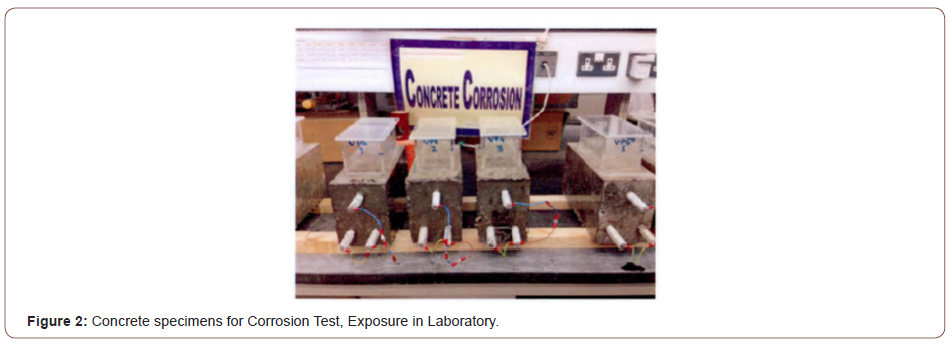

The ASTM G 109, 2013 [8] accelerated corrosion test was first developed to study the effect of chemical admixtures on the corrosion performance of steel reinforcement. This test method is used to evaluate materials intended to inhibit chloride-induced corrosion of steel in concrete. Reinforced concrete specimens (control and inhibited concrete) were prepared according to the relevant ASTM standards (Abdulsalam et. al., 2015) of mixing and preparing concrete specimens. Each specimen has a size of 279 mm x 152 mm x 114 mm, with one rebar at the top and two rebar at the bottom. In laboratory the specimens were subjected to cycles of wetting (ponding) with 3% NaCl solution for two weeks and drying for another two weeks (Figure 2&3).
In corrosion test, the corrosion potential of the steel reinforcement in the concrete is measured using the Great Dane corrosion meter. The results of the Great Dane coincide with the results of the macro-cell current.
The corrosion potential of a steel-reinforced concrete specimen, according to ASTM-C876, indicates the occurrence of corrosion activity in the embedded reinforcing steel bar (ASTM-C876, 2009) [7]. ASTM-C876 states there is threshold at -200 mV and -350 mV. If the corrosion potential is less than -200 mV, then there is a greater than 90% probability that no reinforcing steel corrosion is occurring in that area at that time of measurement. If the corrosion potential is greater than -200 mV and less than -350 mV, then the corrosion activity of the reinforcing steel in that area is uncertain. If the corrosion potential is greater than -350 mV, then there is a greater than 90% probability that reinforcing steel corrosion is occurring in that area at that time of measurement.
Result of Testing
Compressive strength
Results of compressive strength for mixes with w/c ratio 0.4 are shown in Figure 4 and 5, and compressive strength results for mixes with w/c of 0.6 are shown in Figure 6 and 7. The results indicated that for w/c of 0.4, OPC attained the lowest strength development after seawater and normal water curing; whereas, all mixes with w/c of 0.6 presented almost the same strength development. All mixes of 0.4 and 0.6 w/c showed better strength development in normal water curing than in seawater curing.
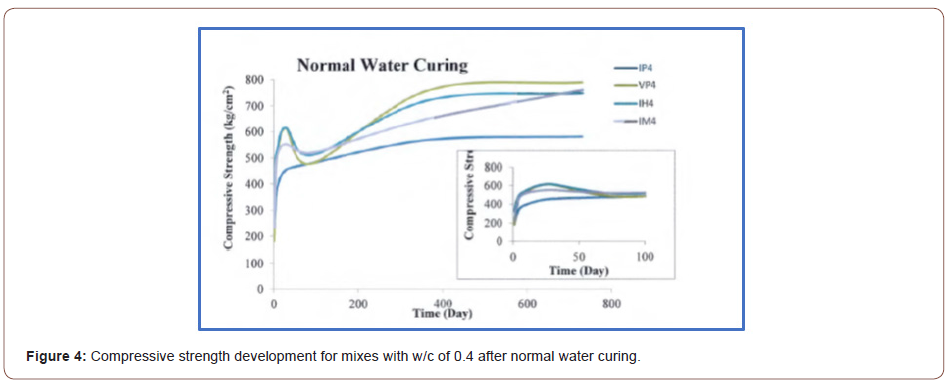
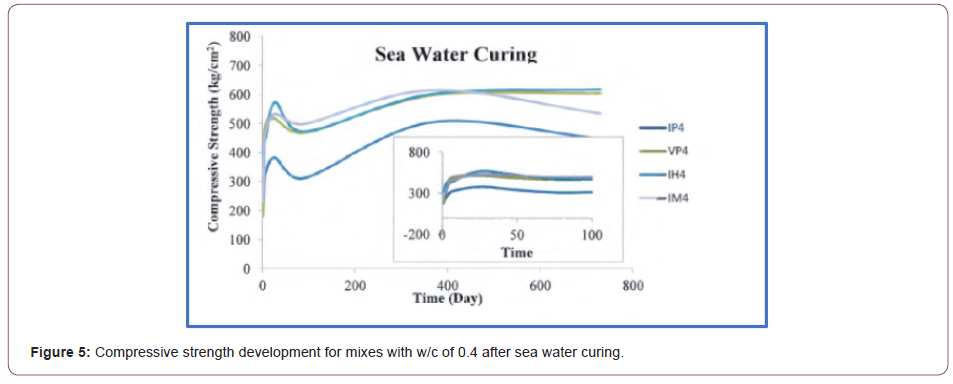


Water absorption test (British Standard 1881-122:2011)
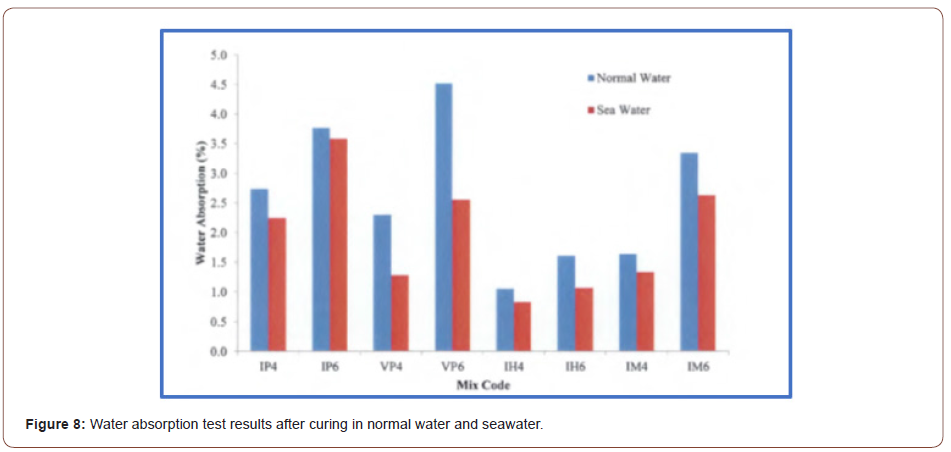
Water absorption properties of different mixes were studied by preparing preliminary mixes, and actual mixes and a comparative study was performed. The results of the water absorption test for all mixes are shown in Figure 8 and 9. The water absorption test results for all mixes cured in seawater were less than those in normal water as shown in Figure 8. From the results of these tests, it is clear that as the water cement ratio increased, the percentage of water absorbed increased. Also, the water absorption depended on the type of cement; control mix with OPC absorbed more water than mix with SRC for both normal water-cured and seawater-cured samples at 0.4w/c ratio. However, at higher w/c ratio of 0.6 and for normal water cured samples, OPC performed better than SRC.
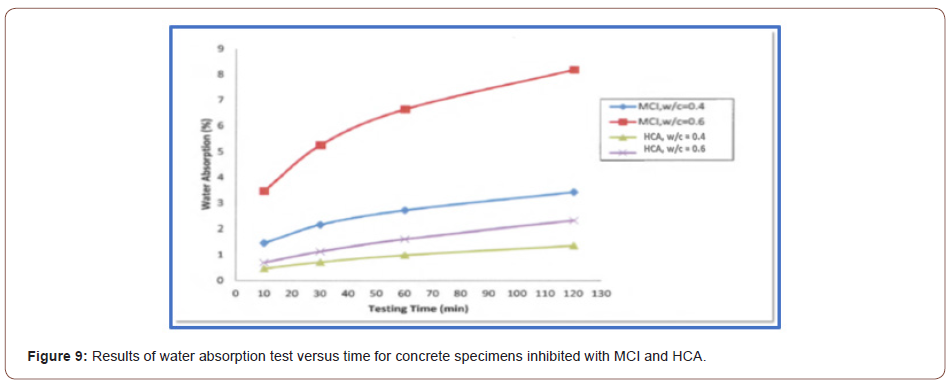
Concrete mixes prepared with HCA at 0.4 w/c ratio showed the least water absorption. The addition of both corrosion inhibitors to concrete resulted in a decrease in water absorption compared to control mix with OPC; however, the performance was better with HCA than with MCI at both w/c ratios. The performance of MCI toward water absorption depended on the w/c ratio; it performed well at lower w/c ratio of 0.4, whereas water absorption for the mix with MCI was higher at 0.6w/c ratio.
For the mixes with inhibitors or admixtures, the test was done at four intervals (10, 30, 60, 120 min) as per the requirement of the standard, as shown in Figure 7. The addition of HCA to the concrete significantly decreased the amount of water absorbed by concrete, HCA performs the dual action of corrosion-inhibition and waterproofing concrete admixture. While the water absorption results in Figure 8 indicated that, the addition of MCI to concrete would not affect the amount of water absorbed by concrete specimen. Because the MCI migrates toward the reinforcement and forms a monomolecular layer that inhibits the corrosion reaction on both the anodic and cathodic components of the corrosion cell and has no water proofing effect.
Electrical indication test for resistance chloride ion penetration (ASTM C1202, 2010)
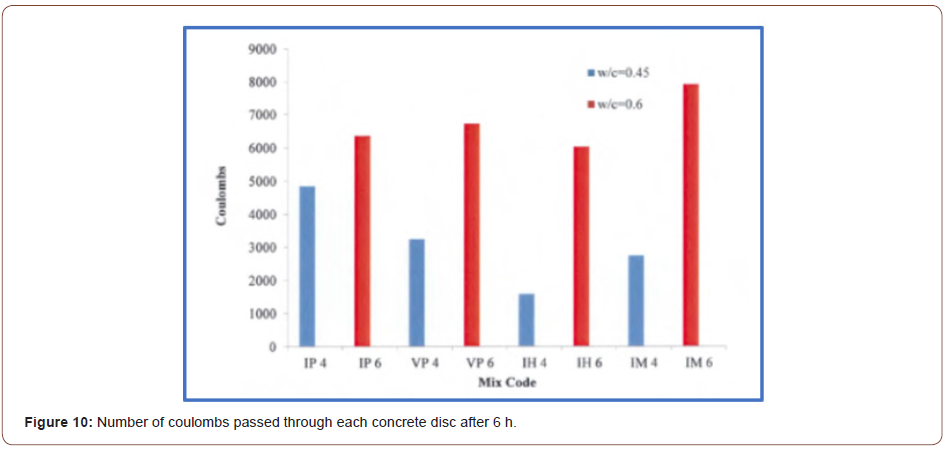
Figure 10 shows the total charge passed in six hours through the concrete discs. From Figure 10, at low w/c ratio, the HCA’s concrete demonstrates the highest resistance to chloride ion penetration, while the OPC concrete shows the lowest resistance. If we compare the results in Figure 10 and the chloride ion penetrability based on column passed values described in ASTM C 1202 in table 11, it is concluded that all mixes with w/c of 0.6 have shown high chloride ion penetrability. Also, if the results for the 4 mixes with w/c of 0.4 in Figure 10 are compared with the values in Table 4, it is clear that the OPC concrete showed high penetrability, and VSC and MIC concretes showed moderate chloride penetrability, whereas, HCA concrete showed low chloride penetrability. This would indicate the efficiency of adding HCA to concrete to increase the resistance of concrete against chloride ion penetration.
Table 4: Age distribution

Corrosion measurement of embedded steel reinforcement in concrete exposed to sea water environment (ASTM G109-7, 2013)
Laboratory test result: Figure 11 shows the corrosion potential reading of eight different concrete mixes samples when subjected to cycles of wetting and drying with 3% NaCl solution for 24 months test duration. From the figure and according to ASTM C876 criteria, it can be concluded that the control concrete and SRC concrete, both with w/c ratio of 0.6, are within the region of 90% probability that the corrosion of steel reinforcement is occurring. MCI concrete with w/c of 0.6 passed the threshold in cycle 19 to the region of 90% probability that corrosion is occurring, but HCA concrete with the same w/c is in the region where corrosion is uncertain. However, all the mixes with w/c of 0.4 fall within the range of 90% probability that no reinforcing steel corrosion is taking place except the plain concrete that passed the threshold to the area where corrosion is uncertain.
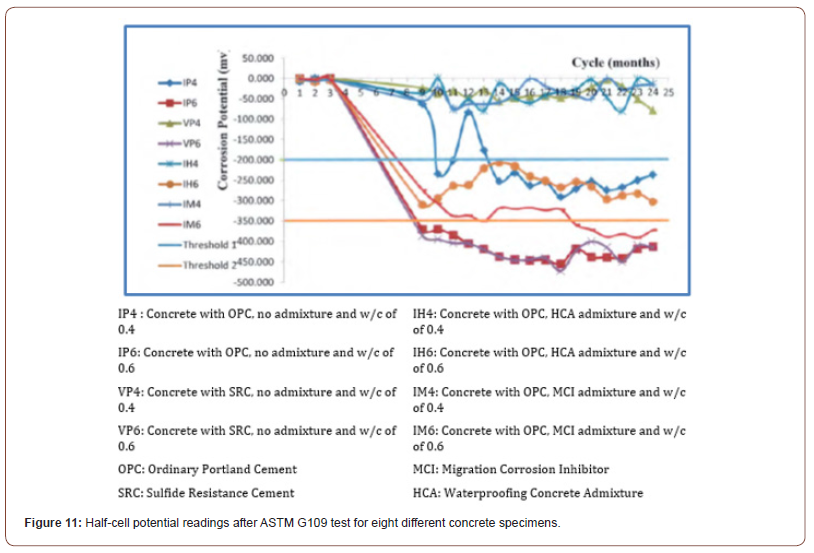
Field test result: Field-testing stations with the total 24 concrete block samples were placed at the site adjacent to the seashore. Two sets of specimens were immersed in the tidal zone while the other set was mounted on the steel racks for atmospheric exposure. Concrete specimens were exposed on site to local environmental conditions at two exposure zones as follow:
1. Tidal zone: The specimens were exposed to wetness and dryness corresponding to high and low tides
2. Atmospheric zone: The concrete specimens were placed on racks exposed to humid coastal conditions, salt-laden winds and some pollution materials from the refinery. Figures 12 and 13 illustrate the corrosion potential measurement for each specimen type versus time. The corrosion potential and electrical resistance measurements were recorded using the Great Dane device. Figure 12 indicates that there is a greater than 90% probability that no reinforcing steel corrosion is occurring in all atmospheric specimens located at the seaside. Figure 13 indicates that the tidal specimen, IH4 and IM4 are the only specimen to have a greater than 90% probability that no reinforcing steel corrosion is occurring. The corrosion activity of the reinforcing steel is uncertain for specimens VP4 and IP4 and there is a greater than 90% probability that reinforcing steel corrosion is occurring in specimens IP6 and VP6, then specimens IH6 and IM6 after the ninth exposure cycle.
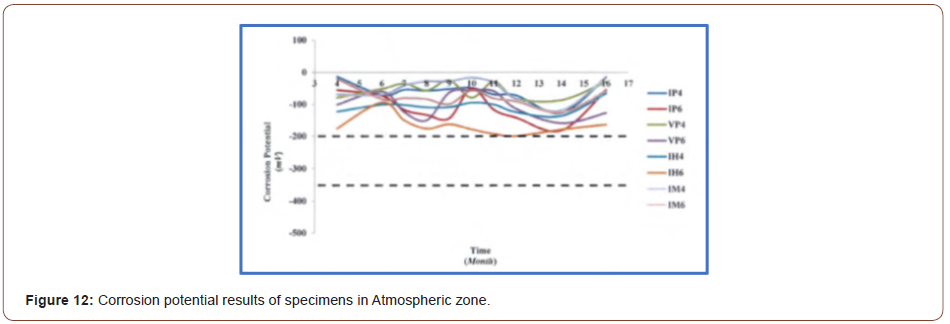
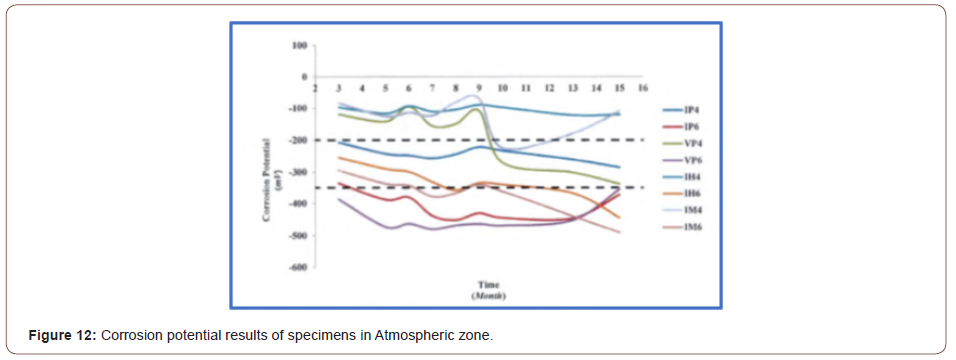
Conclusion
• The field and laboratory tests results of concrete specimens have shown the effectiveness of adding corrosion inhibitor to concrete in enhancing its performance to resist the ingress of chloride ions and corrosion.
• Using sulfate resistant cement had made slight and sometimes negligible improvement to the concrete durability exposed to chloride-rich environment.
• The specimens with a 0.6 w/c ratio in all field and laboratory tests have shown to have more negative corrosion potential values, thus, making it evident that an increase in the w/c ratio would increase the susceptibility of corrosion activity occurrences.
• Results indicated that there was shown 90% probability that no corrosion activities were taking place in atmospheric zone concrete specimens, which could be due to lack of water exposure. However, concrete specimens in the atmospheric zone with w/c ratios of 0.6 have shown higher corrosion potential values than that with w/c of 0.4.
• Waterproofing Concrete Admixture exhibited the best performance in improving the concretes durability among the other corrosion reduction systems used in this study.
• Corrosion Inhibiting admixtures are second defense of protection to steel rebar against corrosion and chloride attack, and nothing will compensate for proper High Performance Concrete mix design. At 0.40 w/c-ratio concretes with have performed better with regard to resisting chloride penetration. Nevertheless, concretes at 0.40 w/c and lower perform very well in resisting chloride penetration.
To read more about this article...Open access Journal of Modern Concepts in Material Science
Please follow the URL to access more information about this article
To know more about our Journals...Iris Publishers
To know about Open Access Publishers





No comments:
Post a Comment